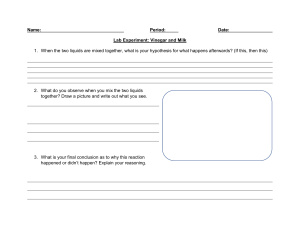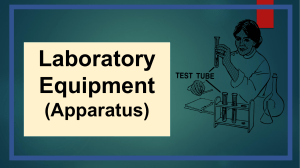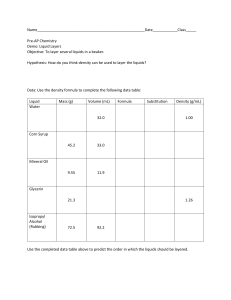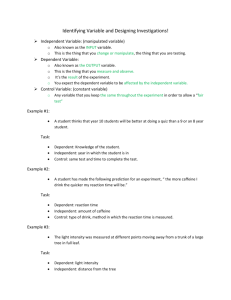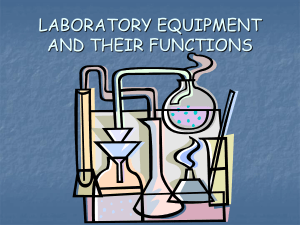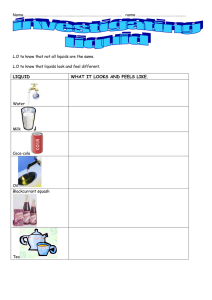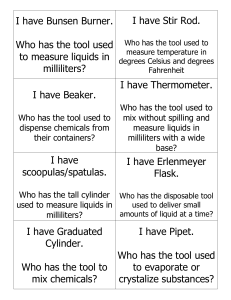Common Lab Apparatus: Chemistry for Engineers Exercise
advertisement
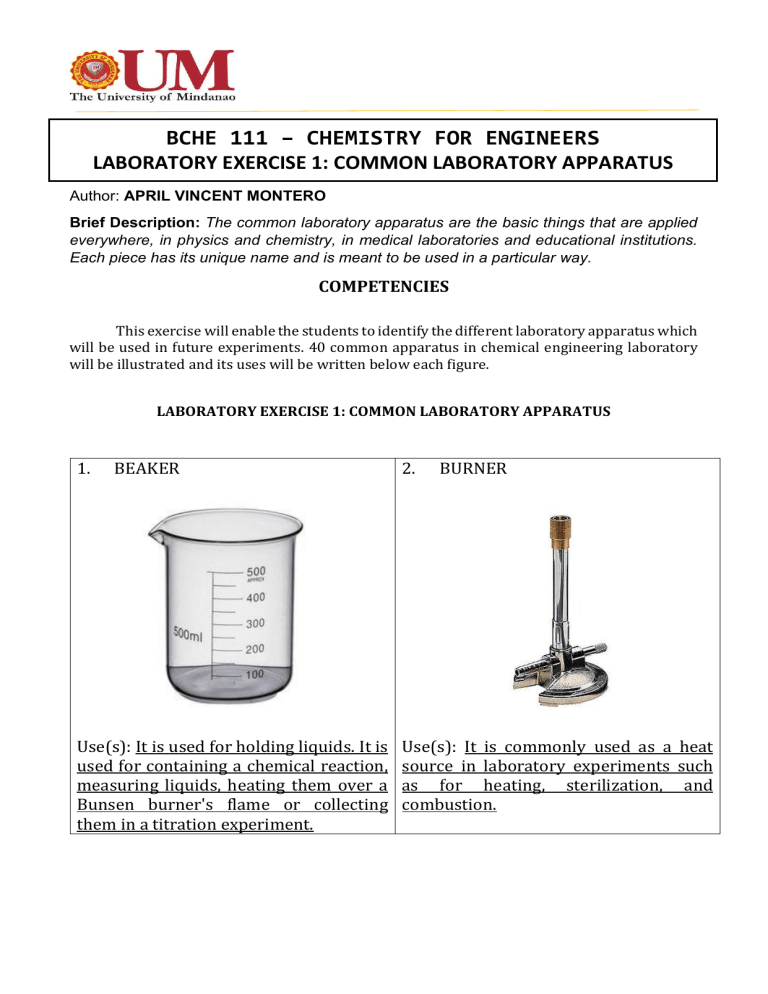
BCHE 111 – CHEMISTRY FOR ENGINEERS LABORATORY EXERCISE 1: COMMON LABORATORY APPARATUS Author: APRIL VINCENT MONTERO Brief Description: The common laboratory apparatus are the basic things that are applied everywhere, in physics and chemistry, in medical laboratories and educational institutions. Each piece has its unique name and is meant to be used in a particular way. COMPETENCIES This exercise will enable the students to identify the different laboratory apparatus which will be used in future experiments. 40 common apparatus in chemical engineering laboratory will be illustrated and its uses will be written below each figure. LABORATORY EXERCISE 1: COMMON LABORATORY APPARATUS 1. BEAKER Use(s): It is used for holding liquids. It is used for containing a chemical reaction, measuring liquids, heating them over a Bunsen burner's flame or collecting them in a titration experiment. 2. BURNER Use(s): It is commonly used as a heat source in laboratory experiments such as for heating, sterilization, and combustion. 3. BURETTE CLAMP Use(s): It is used specifically to hold and secure a burette on a stand, so that a burette is fixed and more convenient for the experiment. 5. CORK BORER 4. CLAY TRIANGLE Use(s): Used to hold crucibles and porcelain dishes heated by a Bunsen burner. Distributes heat evenly over the surface of objects it holds. 6. CRUCIBLE WITH COVER Use(s): It is used for boring holes in Use(s): It is used in the laboratory to corks or rubber stoppers to insert glass contain chemical compounds when tubing. It consists of a plated tubing with heated to extremely high temperatures. precision ground cutting edges. 7. CRUCIBLE TONG 8. DISTILLING FLASK Use(s): It used to lift a hot crucible from Use(s): It is used to separate mixtures of a furnace or for other items which two liquids with different boiling points. cannot be handled with bare hands. 9. ERLENMEYER FLASK 10. EVAPORATING DISH Use(s): It is used to contain liquids and Use(s): It is used for the evaporation of for mixing, heating, cooling, incubation, solutions and supernatant liquids, and filtration, storage, and other liquid- sometimes to their melting point. handling processes. 11. FLORENCE FLASK Use(s): It is used as a container to hold liquids. It is designed for uniform heating, boiling, distillation and ease of swirling. 13. GRADUATED CYLINDER 12. FUNNEL Use(s): It is used to channel liquids or fine-grained chemicals (powders) into labware with a narrow neck or opening. 14. IRON RING Use(s): It is used to measure the volume Use(s): It is commonly used in chemistry of a liquids, chemicals or solutions laboratories for supporting apparatus during the lab daily work. above the work surface. 15. IRON RING STAND Use(s): It is used to supports the iron ring when heating substances or mixtures in a flask or beaker (using a Bunsen burner). 17. MORTAR AND PESTLE 16. MEDICINE DROPPER Use(s): It is used to transfer liquids from one place to another, as well as to drop liquids into solutions or onto surfaces. 18. PETRI DISH Use(s): It is used to crush up solid Use(s): It is used to contain a thin layer chemicals into smaller pieces, or to grind of agar on which to grow bacteria and solids into fine powder. fungi. 19. PINCH COCK 20. PIPET Use(s): It is used to regulate or close a Use(s): It is used to measure out or flexible tube, especially in laboratory transfer small quantities of liquid, in apparatus. volumes of milliliters (mL), microliters (μL). 21. REAGENT BOTTLE 22. SPATULA Use(s): It is used to contain chemicals in Use(s): It is used to help with mixing, liquid or powder form for laboratories scraping, and other tasks related to and stored in cabinets or on shelves. transferring materials and samples from one place to another. 23. STIRRING ROD 24. STOPPERS (CORK & RUBBER) Use(s): It is used to mix chemicals and Use(s): It is used in laboratories to liquids for reaction purposes. securely seal vessels. It is used not only to prevent spills, but also to trap noxious fumes or to allow the vessel to be shaken. 25. TEST TUBE 26. TEST TUBE BRUSH Use(s): It is used in laboratory to handle Use(s): It is used for cleaning test tubes. chemicals, especially for qualitative These brushes are very durable and have experiments and assays. hog bristles and a wire body. 27. TEST TUBE HOLDER Use(s): It is used to hold one test tube. By squeezing the handle, the holder's spring-loaded jaws open in order to grip the test tube. 29. THERMOMETER 28. TEST TUBE RACK Use(s): It is used to hold multiple test tubes upright at the same time. It is used for organizing test tubes when different solutions are being worked on or collected at once. 30. TRIANGULAR FILE Use(s): It is used to measure Use(s): It is often used to stir chemicals, temperature with a high level of as well as to scratch glass tubing before precision for applications. breaking it. 31. DIGITAL BALANCE 32. TRIPOD Use(s): It is used for weighing Use(s): It is used to support or hold the substances to the milligram (0.001 g) flasks and beakers during experiments. level. 33. UTILITY CLAMP Use(s): It is used to support flasks, beakers, and burettes. They stabilize your sample containers, preventing possible breakage and sample loss. 34. VOLUMETRIC FLASK Use(s): It is used when it is necessary to know both precisely and accurately the volume of the solution that is being prepared. 35. WASH BOTTLE 36. WATCH GLASS Use(s): It is used to supply precise and Use(s): It is used to evaporate liquids small quantities of various liquids. and cover beakers during sample preparation. 37. PETRI DISH 38. WATER TROUGH Use(s): It is used to contain a thin layer Use(s): It is used for collecting gases, of agar on which to grow bacteria and such as hydrogen, oxygen and nitrogen fungi. and also liquids. 39. pH METER 40. WIRE GAUZE Use(s): It is used to measure hydrogen Use(s): It is used to diffuse the heat, ion activity in solutions. helping to protect the glassware.
